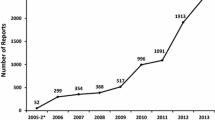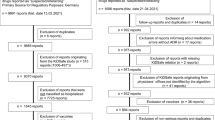Abstract
Purpose
Adverse drug reactions (ADRs) are a major patient safety issue, and a substantial proportion of ADRs are, in fact, preventable. The aim of this study was to describe the proportion and pattern of preventable ADRs in spontaneously reported suspected ADRs and to study the feasibility of using data from an ADR reporting system for this purpose.
Methods
All reports of ADRs, except those in which a vaccine was the suspected drug, submitted to the regional pharmacovigilance center of southeastern Sweden between 2008 and 2009 were analyzed. Causality between the suspected ADR and the medication was assessed using the World Health Organization (WHO) criteria, and preventability was assessed using Hallas criteria.
Results
During the study period, 1,290 ADRs were received and 1,255 were classified as having at least a possible causality between a reaction and a drug. Of these, 172 (14%) ADRs were considered preventable, 35 (20%) were classified as definitely preventable, and 137 (80%) as possibly preventable. Of all preventable ADRs, 96 (56%) were related to prescribing, 35 (20%) to administration, and 41 (24%) to clinical and laboratory monitoring of treatment. Warfarin, oxycodone, and ioversol were the most common drugs with preventable ADRs.
Conclusions
This study found that a substantial part of reported ADRs are preventable. Most of these are related to drug prescription, suggesting that interventions aiming to reduce preventable ADRs should focus on this process. Moreover, systems for ADR reporting may be useful in the mission of reducing the unsafe use of drugs.
Similar content being viewed by others
References
Hartholt KA, van der Velde N, Looman CW, Panneman MJ, van Beeck EF, Patka P, van der Cammen TJ (2010) Adverse drug reactions related hospital admissions in persons aged 60 years and over, The Netherlands, 1981-2007: less rapid increase, different drugs. PLoS One 5(11):e13977. doi:10.1371/journal.pone.0013977
Pirmohamed M, James S, Meakin S, Green C, Scott AK, Walley TJ, Farrar K, Park BK, Breckenridge AM (2004) Adverse drug reactions as cause of admission to hospital: prospective analysis of 18 820 patients. BMJ 329(7456):15–19. doi:10.1136/bmj.329.7456.15
Davies EC, Green CF, Taylor S, Williamson PR, Mottram DR, Pirmohamed M (2009) Adverse drug reactions in hospital in-patients: a prospective analysis of 3695 patient-episodes. PLoS One 4(2):e4439. doi:10.1371/journal.pone.0004439
Lundkvist J, Jonsson B (2004) Pharmacoeconomics of adverse drug reactions. Fundam Clin Pharmacol 18(3):275–280. doi:10.1111/j.1472-8206.2004.00239.x
Bates DW, Spell N, Cullen DJ, Burdick E, Laird N, Petersen LA, Small SD, Sweitzer BJ, Leape LL (1997) The costs of adverse drug events in hospitalized patients. Adverse Drug Events Prevention Study Group. JAMA 277(4):307–311
Thomsen LA, Winterstein AG, Sondergaard B, Haugbolle LS, Melander A (2007) Systematic review of the incidence and characteristics of preventable adverse drug events in ambulatory care. Ann Pharmacother 41(9):1411–1426. doi:10.1345/aph.1H658
Soop M, Fryksmark U, Koster M, Haglund B (2009) The incidence of adverse events in Swedish hospitals: a retrospective medical record review study. Int J Qual Health Care 21(4):285–291. doi:10.1093/intqhc/mzp025
Aranaz-Andres JM, Aibar-Remon C, Vitaller-Burillo J, Requena-Puche J, Terol-Garcia E, Kelley E, Gea-Velazquez de Castro MT, the Ewg (2009) Impact and preventability of adverse events in Spanish public hospitals: results of the Spanish National Study of Adverse Events (ENEAS). Int J Qual Health Care 21(16):408–414. doi:10.1093/intqhc/mzp047
Krahenbuhl-Melcher A, Schlienger R, Lampert M, Haschke M, Drewe J, Krahenbuhl S (2007) Drug-related problems in hospitals: a review of the recent literature. Drug Saf 30(5):379–407
Kanjanarat P, Winterstein AG, Johns TE, Hatton RC, Gonzalez-Rothi R, Segal R (2003) Nature of preventable adverse drug events in hospitals: a literature review. Am J Health Syst Pharm 60(17):1750–1759
Jönsson AK, Hakkarainen KM, Spigset O, Druid H, Hiselius A, Hägg S (2009) Preventable drug related mortality in a Swedish population. Pharmacoepidemiol Drug Saf 19(2):211–215. doi:10.1002/pds.1890
Jonville-Bera AP, Saissi H, Bensouda-Grimaldi L, Beau-Salinas F, Cissoko H, Giraudeau B, Autret-Leca E (2009) Avoidability of Adverse Drug Reactions Spontaneously Reported to a French Regional Drug Monitoring Centre. Drug Saf 32(5):429–440
Winterstein AG, Hatton RC, Gonzalez-Rothi R, Johns TE, Segal R (2002) Identifying clinically significant preventable adverse drug events through a hospital's database of adverse drug reaction reports. Am J Health Syst Pharm 59(18):1742–1749
WHO Collaborating Centre for Drug Statistics Methodology, Guidelines for ATC classification and DDD assignment (2009)
World Healt Organisation Collaborating Centre for International Drug Monitoring. Adverse Reaction Terminology (1991)
Lindquist M, Edwards IR (2001) The WHO Programme for International Drug Monitoring, its database, and the technical support of the Uppsala Monitoring Center. J Rheumatol 28(5):1180–1187
Wester K, Jönsson A, Spigset O, Hägg S (2007) Spontaneously reported fatal suspected adverse drug reactions: a 10-year survey from Sweden. Pharmacoepidemiol Drug Saf 16(2):173–180. doi:10.1002/pds.1263
Hallas J, Harvald B, Gram LF, Grodum E, Brosen K, Haghfelt T, Damsbo N (1990) Drug related hospital admissions: the role of definitions and intensity of data collection, and the possibility of prevention. J Intern Med 228(2):83–90
Howard RL, Avery AJ, Howard PD, Partridge M (2003) Investigation into the reasons for preventable drug related admissions to a medical admissions unit: observational study. Qual Saf Health Care 12(4):280–285
Jones TA, Como JA (2003) Assessment of medication errors that involved drug allergies at a university hospital. Pharmacotherapy 23(7):855–860
Seeger JD, Kong SX, Schumock GT (1998) Characteristics associated with ability to prevent adverse drug reactions in hospitalized patients. Pharmacotherapy 18(6):1284–1289
Tramer MR, von Elm E, Loubeyre P, Hauser C (2006) Pharmacological prevention of serious anaphylactic reactions due to iodinated contrast media: systematic review. BMJ 333(7570):675. doi:10.1136/bmj.38905.634132.AE
Lutomski DM, Lafollette JA, Biaglow MA, Haglund LA (2008) Antibiotic allergies in the medical record: effect on drug selection and assessment of validity. Pharmacotherapy 28(11):1348–1353. doi:10.1592/phco.28.11.1348
Zwart-van Rijkom JE, Uijtendaal EV, ten Berg MJ, van Solinge WW, Egberts AC (2009) Frequency and nature of drug-drug interactions in a Dutch university hospital. Br J Clin Pharmacol 68(2):187–193. doi:10.1111/j.1365-2125.2009.03443.x
Bertsche T, Pfaff J, Schiller P, Kaltschmidt J, Pruszydlo MG, Stremmel W, Walter-Sack I, Haefeli WE, Encke J (2010) Prevention of adverse drug reactions in intensive care patients by personal intervention based on an electronic clinical decision support system. Intensive Care Med 36(4):665–672. doi:10.1007/s00134-010-1778-8
Jönsson AK, Spigset O, Jacobsson I, Hägg S (2007) Cerebral haemorrhage induced by warfarin - the influence of drug-drug interactions. Pharmacoepidemiol Drug Saf 16(3):309–315. doi:10.1002/pds.1291
Kucher N, Connolly S, Beckman JA, Cheng LH, Tsilimingras KV, Fanikos J, Goldhaber SZ (2004) International normalized ratio increase before warfarin-associated hemorrhage: brief and subtle. Arch Intern Med 164(19):2176–2179. doi:10.1001/archinte.164.19.2176
Ducharme MM, Boothby LA (2007) Analysis of adverse drug reactions for preventability. Int J Clin Pract 61(1):157–161. doi:10.1111/j.1742-1241.2006.01130.x
Pearson TF, Pittman DG, Longley JM, Grapes ZT, Vigliotti DJ, Mullis SR (1994) Factors associated with preventable adverse drug reactions. Am J Hosp Pharm 51(18):2268–2272
Hanlon JT, Pieper CF, Hajjar ER, Sloane RJ, Lindblad CI, Ruby CM, Schmader KE (2006) Incidence and predictors of all and preventable adverse drug reactions in frail elderly persons after hospital stay. J Gerontol A Biol Sci Med Sci 61(5):511–515
Bäckstrom M, Mjörndal T, Dahlqvist R (2004) Under-reporting of serious adverse drug reactions in Sweden. Pharmacoepidemiol Drug Saf 13(7):483–487. doi:10.1002/pds.962
Hazell L, Shakir SA (2006) Under-reporting of adverse drug reactions: a systematic review. Drug Saf 29(5):385–396
Ferner RE, Aronson JK (2010) Preventability of drug-related harms - part I: a systematic review. Drug Saf 33(11):985–994. doi:10.2165/11538270-000000000-00000
Hakkarainen KM, Andersson Sundell K, Petzold M, Hägg S (2012) Methods for assessing preventability of adverse drug events: a systematic review. Drug Saf 35(2):105–126. doi:10.2165/11596570-000000000-0000
Acknowledgement
This study was funded by the County Council of Östergötland and the Swedish Medical Product Agency.
Conflict of interest
Henrik Lövborg’s wife is an employee of a company (MEDAC) whose products are part of this study (as is the case for many other companies).
Author information
Authors and Affiliations
Corresponding author
Rights and permissions
About this article
Cite this article
Lövborg, H., Eriksson, L.R., Jönsson, A.K. et al. A prospective analysis of the preventability of adverse drug reactions reported in Sweden. Eur J Clin Pharmacol 68, 1183–1189 (2012). https://doi.org/10.1007/s00228-012-1237-2
Received:
Accepted:
Published:
Issue Date:
DOI: https://doi.org/10.1007/s00228-012-1237-2




